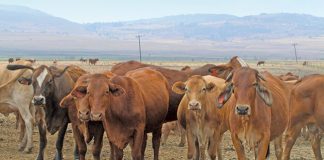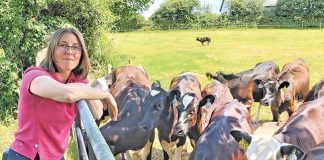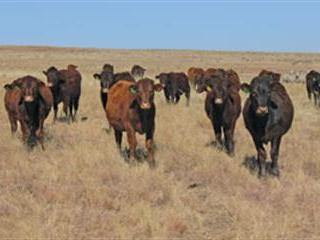
The Vrede district in the north-eastern Free State is known to be a good beef producing area. Summers are generally mild and winters cold, with temperatures as low as -10°C. The hard winters mean that the period from June to September is a lean one in feed terms. Cattle must have good, rested veld or maize stover available, and hay with a high quality lick must be supplied during this period.
As a newcomer to the Vrede district, James Stephen had to learn on his feet. His farm Bronkhorstfontein’s natural and man-made resources had been somewhat neglected. When he moved to the farm in September 2009, many of the internal fences were missing and others were in poor shape. Except for two neglected Eragrostis curvula pastures totalling 14ha, the lands had not been worked for some time, and camps close to the kraal were invaded by weeds.
.jpg)
James Stephen
On the positive side, much of the veld (mainly red grass, Themeda triandra) was in fairly good condition. It was a question of making do while the 430ha farm was slowly brought back to its productive potential. The first and most urgent task, apart from renewing kilometres of fencing, was to re-establish 50ha of old lands to get them back to producing hay for winter feed.
Building the herd
While these lands were being planted, James started building up a herd of registered Sussex cows and commercial Afrex (Sussex/Afrikaner) cows. James recalled the herds of his great uncles in Viljoenskroon. Both were leading Sussex0 breeders and he felt an affinity with the breed. With the help of Dallas Phillips of the Sussex Cattle Breeders Society of South Africa, he started buying registered Sussex animals to stock Bronkhorstfontein.
Cows bought in the Marquard and Ladybrand areas adapted fairly quickly to the mixed sourveld grazing in Vrede, but animals that came in from different veld types took more than a year to adjust. Conditions in the eastern Free State are tougher than most people realise, with a wide temperature range from daytime highs to night-time lows. In addition to having to adapt to different grazing conditions, cattle new to the area had to cope with these temperature extremes.
Fertility
The calving rate did not drop much below 80% during the adaptation period and is now approaching 86%. In 2011, with an ICP of 397 days, the Vigorex Stud achieved a top place in the annual Sussex Society’s small herd fertility awards. The advantage of bringing cattle in from outside the area, apart from invigorating genetics, is that once they adapt to the extreme conditions, they can adapt virtually anywhere else in the country.
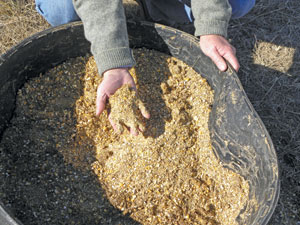
A lick is fed during winter to supplement roughage.
The 50 registered females older than two years have now settled into their new environment and are producing quality calves that are doing well. To serve the herd, James bought a proven polled sire CN 05/115 from Huntersvlei, and another, JVB 07/047, from Jan van Biljon who farms between Viljoenskroon and Bothaville in the Free State.
“The easiest route for a new breeder is to buy an older but proven registered bull from a reputable breeder,” he explains. “This has really paid off in my case, and with help from Anthony Evans of Huntersvlei, has gone a long way to putting my new Vigorex Sussex Stud on the map.”
Productive system
Due to the relatively high rainfall (680mm/year) and consequent high plant biomass production, the stocking rate in the Vrede area is generally between 3ha/MLU and 4ha/MLU. This season Bronkhorstfontein’s rainfall up to the end of March was 580mm, about 15% below the long term mean. Having planted 25ha of Eragrostis curvula and Eragrostis tef pasture, James has been impressed with the performance of teff in what has proven to be a very dry season.
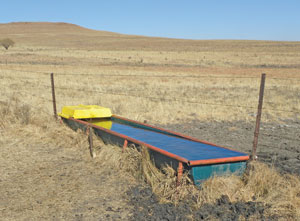
Establishing good stock watering points was a priority for James.
“This species originally comes from Ethiopia, where it evolved in dry conditions,“ he points out. “It has made a huge difference to my 2012 fodder flow. I doubt whether I would have managed the winter without it, as the older Eragrostis curvula lands have not shown good growth this year, in spite of being well fertilised. However, Eragrostis curvula is a perennial species while Eragrostis tef is an annual.”
Expansion
James recently acquired an adjoining farm and increased the size of his holding to 615ha veld and 65ha arable land. He plans to expand his stud herd by 50%. “Overall I am pleased with the performance of the registered cows, “ he says. “Their calves are at least 20kg heavier at seven months than those of the average commercial cows.”
He admits he’s learned some hard lessons bringing his farm back into production. “Firstly, I put myself under pressure by taking on a neglected farm. It’s possible to get it back into production, but it’s more expensive and takes longer than I thought it would. Capital investment and maintenance had been neglected by previous owners. I had to invest heavily in getting fences, buildings, water points, a wind pump and lands back into shape.”
James looked at grazing land in the Viljoenskroon district, but it was scarce and expensive when available. He then decided to settle for the Vrede area with its cooler climate and fairly reliable rainfall. “A benefit of farming in this area is the good quality grazing combined with fewer tick problems,” he points out. “I have not seen redwater here and have only treated the cattle for blue ticks twice this season.”
In what may be something of a record in the Sussex industry, James has sold a number of stud bulls in less than three years since buying his first cows. He believes in the merits of polled genetics and develops this economically important trait in his stud. His primary stud sire CN05/115 is polled and he has bought a semen share in another top polled bull GA09/018, owned by Huntersvlei, which he will use to inseminate his heifers. He anticipates that at least a third of the bulls he sells in future will be polled, as the demand for polled Sussex cattle is constantly growing.
Contact James Stephen on 082 494 0015 or email [email protected]











